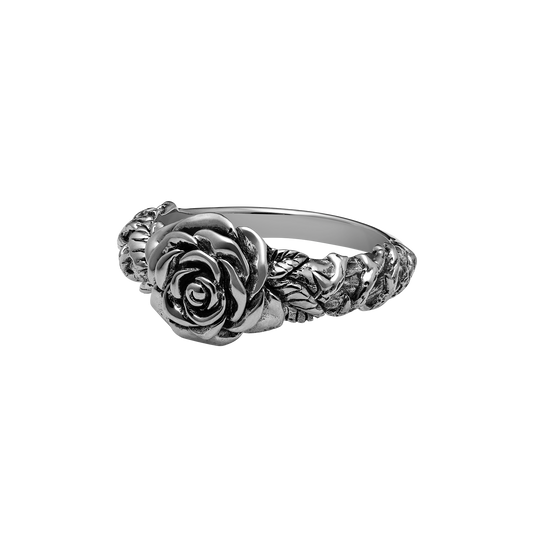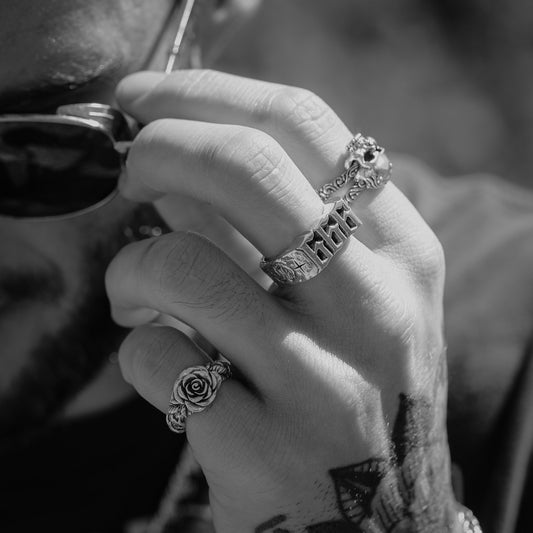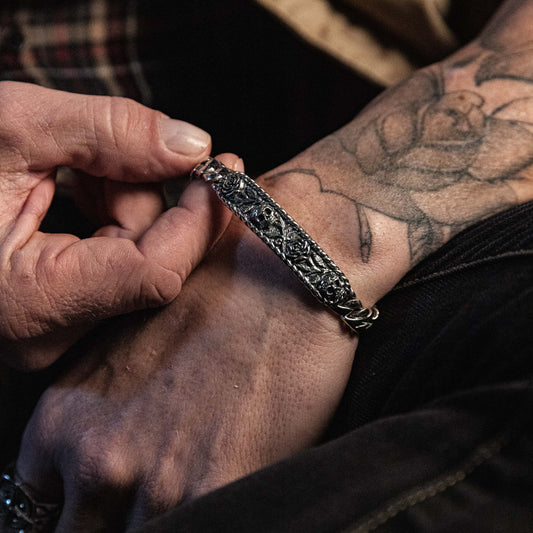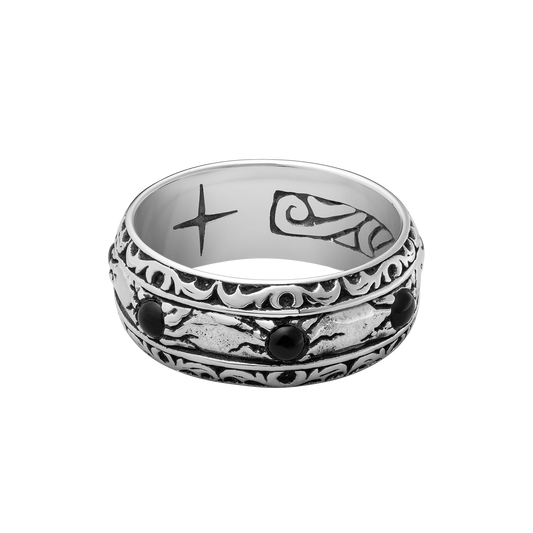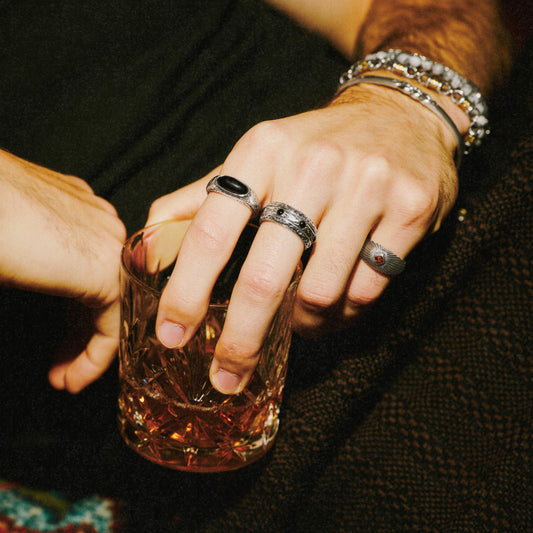Sterling Silver vs. White Gold: The Complete Guide
Wearing the right jewels has more than just a decorative purpose. Its weight. It's about perpetuation. It's the way metal grows with you, accumulating stories, scars, and personality along the way. The choice between sterling silver and white gold is about more than just brilliance. It's all about tradition, craftsmanship, and what you want your jewelry to say about you.
Silver thrives on change. It marks, it tarnishes, it evolves with every ride and every night on the road. White gold, on the other hand, resists. It carries prestige, tradition, and permanence, polished, ceremonial, engineered to last.
Both metals are timeless. Both are precious. But they couldn’t be more different in the way they wear, age, and demand attention. This guide cuts through the noise to give you everything you need to know about sterling silver vs. white gold, so you can decide which belongs on your hand, around your neck, or passed down for generations.

Where They Come From
Every metal carries history in its weight.
Sterling Silver:
Silver has been forged into tools, weapons, and adornments for thousands of years. Sterling silver, 92.5% pure silver mixed with 7.5% copper or other strengthening metals, became the standard in Europe centuries ago. It’s prized for its balance: precious enough to be cherished, strong enough to be worn daily.
From Norse warriors to Spanish conquistadors, silver was a metal that travelled. Today, sterling silver remains the backbone of handcrafted jewelry. Heavy, sculpted, versatile. It holds the mark of artisans and wears the passage of time better than most.
White Gold:
White gold is newer to the stage. It was created in the early 20th century as a substitute for platinum, blending pure gold with palladium, silver, or nickel to give it a lighter tone. Most modern white gold is coated in rhodium, a rare and highly reflective metal that enhances its bright-white appearance and provides protection. By alloying yellow gold with palladium, nickel, or silver, jewellers created a lighter-toned version that could mimic platinum’s brilliance.
Silver was born from tradition. White gold was engineered for refinement.
The Weight of Composition
Sterling Silver:
-
92.5% pure silver, 7.5% copper or other metals
-
Soft compared to alloys like stainless steel or white gold
-
Known for its malleability, easy to shape into intricate designs
-
Ages with a darkened patina, creating contrast and depth
White Gold:
-
Pure gold alloyed with harder metals like palladium, silver, or nickel
-
Usually coated in rhodium for durability and brightness
-
Denser than silver, giving it a heavier feel
- Less malleable, but more resistant to wear
For the wearer, the difference is clear: sterling silver feels raw and evolving. White gold feels polished and engineered.
Durability in the Real World
Your jewelry isn’t meant to sit in a box. It’s meant to live with you, on the road, on the bike, on the stage. That means durability matters.
-
Sterling Silver: Soft enough to scratch and dent, silver also tarnishes when exposed to air, moisture, or chemicals. For some, that’s a weakness. For others, it’s the point. Scratches and patina become part of the piece, evidence of a life well-lived.
-
White Gold: Tougher than silver, resistant to scratches and tarnish. But there’s a catch: its rhodium plating wears off over time, especially on high-contact pieces like rings. Re-plating is necessary every few years if you want to keep that bright, untarnished finish.
In short: silver evolves with you. White gold resists, but requires upkeep to stay flawless.
Silver embraces imperfection. White gold resists it, but at a cost.
The Look and Feel
Aesthetics aren’t just surface deep. Each metal projects a different presence.
-
Sterling Silver: Cool-toned with a brightness that darkens into a rich, storm-worn patina over time or can be cleaned to keep looking brand new. Its look shifts with age: raw, textured, and unmistakably lived-in. Perfect for designs that embrace depth and detail.
- White Gold: Rhodium-coated, mirror-bright, and reflective. Its sheen is more uniform, polished, and refined. While it doesn’t change much on its own, the plating gives it a pristine finish that stays sharp with maintenance.
Silver tells a story through change. White gold tells its story by staying consistent.
Care and Maintenance
Both metals demand care, but in different ways. Silver demands regular attention, but it’s simple. White gold requires less day-to-day care, but bigger interventions over the years.
Sterling Silver Care:
-
Can tarnish naturally over time
-
Clean with a polishing cloth or silver cleaner
-
Can be left to patina for a rugged, weathered look
-
Best stored in anti-tarnish pouches or cases
White Gold Care:
-
Doesn’t tarnish, but scratches will wear down rhodium plating
-
Requires professional re-plating every few years
-
Clean with mild soap and water
- Store separately to avoid scratches
The Value Factor
Price always enters the equation.
-
Sterling Silver: Considered a precious metal, but far more affordable than gold. Its value lies in its accessibility: heavy, substantial jewelry without the premium cost of gold. Silver jewelry delivers weight, substance, and artistry. Its worth lies in craftsmanship and wearability, not market speculation.
- White Gold: Tied directly to the value of gold on the global market. More expensive than silver, it’s often positioned as an investment metal, chosen for wedding bands, heirlooms, and milestone pieces. This increases its cost while also making it a well-known store of wealth. As an investment piece, it is prestigious. Many people choose white gold for reasons other than jewelry, such as permanency and status.
Silver is an accessible luxury. White gold is a high-end investment. Both carry value, but in very different ways.

Symbolism and Lifestyle Fit
For us, jewelry isn’t about trends. It’s about attitude and the life you live.
-
Sterling Silver: The metal of everyday legends. It shifts, scars, and tells your story with every scratch. Worn by bikers and rockers for its weight, texture, and ability to evolve alongside its wearer. Silver is the traveller’s metal. It’s the chain around the biker’s neck, the ring that picks up scratches in every city, the bracelet that weathers salt, sweat, and gasoline. It’s imperfect on purpose. It symbolizes movement, evolution, and story.
- White Gold: The metal of permanence. White gold isn’t pure. It’s an alloy, gold forged with tougher metals like palladium, nickel, or silver. The result? A precious metal with grit. Stronger than raw gold, but still carrying the weight of its legacy. Built to endure, white gold promises not just polish that lasts, but a style that refuses to fade with time. Chosen for milestones like weddings, anniversaries, and legacies. It represents commitment, tradition, and prestige. Where silver is raw, white gold is refined. Where silver evolves, white gold endures.
Choosing the Right Metal for You
So which one is right? That depends on what you want your jewelry to say.
-
Choose Sterling Silver if:
-
You want jewelry that evolves with you
-
You value weight, texture, and history
-
You embrace patina, scratches, and change as part of the design
-
Your lifestyle demands pieces you can wear daily without fear of ruining their “perfect” finish
-
Choose White Gold if:
-
You want jewelry that stays polished and pristine
-
You’re looking for investment or heirloom pieces
-
You prefer refinement over ruggedness
- You want permanence and tradition in your collection
What to Choose?
Choosing between sterling silver and white gold isn’t just about the metal. It’s about the life you want to carve into it.
Sterling silver is the road-worn traveller. It collects scars, builds patina, and evolves with you. Every scratch is a mile. Every darkened edge is proof of where you’ve been. It doesn’t hide its history. It wears loudly.
White gold is the traditionalist. It’s built for stamina, polished for ceremony, engineered to stay pristine. It carries weight not just in grams, but in symbolism, the heirloom, the milestone, the piece that marks a moment and stays frozen there.
Neither is wrong. Both are precious. The real difference is in how they age — and how you want to see yourself reflected in metal.
We work in sterling silver because we believe jewelry should feel alive. Heavy. Weathered. Unapologetic. Made to ride with you, not sit in a box. But the choice is yours: the evolving rawness of silver, or the polished permanence of white gold.
Whatever you choose, don’t pick jewelry to decorate yourself. Pick it to carry your story.
Because in the end, jewelry isn’t just what you wear, it’s what survives. It’s less about which metal is “better”, and more about which one feels like you.
Sterling silver. White gold. Two metals. Two paths. Both forged to endure.
[Explore Sterling Silver Jewelry]






